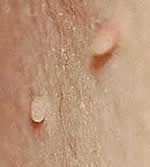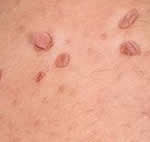
Skin tag
What is a skin tag?
Causes of skin tags
Remedies for skin tags
References
What is a skin tag?
A skin tag (acrochordon, fibroepithelial polyp) is a small benign tumour usually found on the neck, armpit, trunk or groin. They also occur on the face, often on the eyelids. They tend to form in skin creases, or where there is rubbing on the skin. Usually they are the size of a grain of rice, though they can grow larger. The surface of a skin tag can be smooth or irregular.

 They are usually skin colour, sometimes darker shades of brown or grey. The tag is often raised above the surface of the skin on a fleshy stalk called a peduncle. Skin tags are typically harmless and painless, though they can become irritated with touching, picking, rubbing by clothes or jewellery, or shaving. Skin tags are not malignant, and for most people they are a cosmetic problem rather than anything more serious.
They are usually skin colour, sometimes darker shades of brown or grey. The tag is often raised above the surface of the skin on a fleshy stalk called a peduncle. Skin tags are typically harmless and painless, though they can become irritated with touching, picking, rubbing by clothes or jewellery, or shaving. Skin tags are not malignant, and for most people they are a cosmetic problem rather than anything more serious.
Nearly half of all people have a skin tag.
Skin tags are closely related to warts, having some similar causes and remedies.
Causes of skin tags
- Virus. Studies show the occurrence of human papillomavirus (HPV 6 and 11) in skin tags. (1, 2)
- Those who are diabetic or pre-diabetic (suffering from metabolic syndrome or insulin resistance) have a higher incidence of skin tags, as do people who are overweight or obese. It is likely that continual high levels of blood insulin are a primary cause of skin tags. Prolonged insulin is a cause of cancer, and skin tags are a benign form of a cancer. (2, 3, 4)
- Skin tags are associated with PCOS.
- They are associated with seborrheic keratoses.
- They are more common in women than men. Skin tags are associated with high levels of estrogen.
- Rubbing, touching, irritation.
- Skin tags are often inherited in families, so a genetic component is thought to exist.
Remedies for skin tags
- Iodine is the first treatment to try, even better if you mix it with fresh garlic. The most effective remedy is to squeeze the juice out of a clove of garlic, mix it with an equal quantity of Lugol's iodine, and keep the mix refrigerated. Only make about a quarter of a teaspoon, or enough for one or two days. Apply with a cotton bud to the skin tag twice a day. Even better if you cover the wet mix with a plaster. This remedy can remove small skin tags overnight, and is usually effective within two weeks. (5, 6)
- Diet. Eliminate sugars and refined carbohydrates. This means all foods that have added sugar, all sweet fruits, all dried fruit, any fruit juice, bread, cake, biscuits/cookies, anything made with white flour, and all kinds of snacks, especially sweet snacks. This, along with fasting, will help prevent the skin tags from coming back again.
- Fasting or ketogenic diet.
- Garlic.
- Zinc sufficiency is important, because zinc is an effective anti-viral and is required by your immune system.
- Apple cider vinegar.
- View remedies & comments contributed by visitors to Grow Youthful's Ailments & Remedies pages.
References
1. Gupta S, Aggarwal R, Gupta S, Arora SK.
Human papillomavirus and skin tags: Is there any association?
Indian J Dermatol, 2008. Venereol Leprol 74: 222-5.
2. Huang X, Zhao Q, Yang P, Li Y, Yuan H, Wu L, Chen Z.
Metabolic Syndrome and Risk of Cervical Human Papillomavirus Incident and Persistent Infection.
Medicine (Baltimore). 2016 Mar;95(9):e2905. doi:10.1097/MD. 2905. PMID: 26945384; PMCID: PMC4782868.
3. Jeong-a Kim, Yongzhong Wei and James R. Sowers.
Role of Mitochondrial Dysfunction in Insulin Resistance.
29 Feb 2008. Circulation Research. (2008) 107.165472, 102:401-414.
4. Sangwung P, Petersen KF, Shulman GI, Knowles JW.
Mitochondrial Dysfunction, Insulin Resistance, and Potential Genetic Implications.
Endocrinology. 2020 Apr 1;161(4):bqaa017. doi: 10.1210/endocr/bqaa017. PMID: 32060542; PMCID: PMC7341556.
5. Capriotti K, Stewart KP, Pelletier JS, Capriotti J.
A Novel Topical 2% Povidone-Iodine Solution for the Treatment of Common Warts: A Randomized, Double-Blind, Vehicle-Controlled Trial.
Dermatol Ther (Heidelb). 2015 Dec;5(4):247-252. doi: 10.1007/s13555-015-0086-1. Epub 2015 Nov 3. PMID: 26530429; PMCID: PMC4674451.
6. Zahra Beygom Mousavi, Abolfath Mehrabian, Fereshteh Golfakhrabadi, Foroogh Namjoyan.
A clinical study of efficacy of garlic extract versus cryotherapy in the treatment of male genital wart.
Dermatologica Sinica, Volume 36, Issue 4, 2018, Pages 196-199, ISSN 1027-8117.
